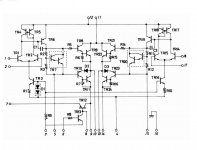Hi folks, I got a question regarding STK4191 amplifier. I made this amplifier with 24-0-24 vac power transformer (400va). The amplifier is rated power is 50x2 watts stereo. I do have another amplifier made with STK4231 MK-2 ic and this one rated power 100X2 watts stereo and I have used 400va 34-0-34 vac transformer. Both are sounds really very nice and clean and has decent amount of clear bass. I think these are cleaner than my class D tda8954th by sounds quality but tda bass really more and massive bass power than STK4191&stk4231MK-2. Questions are is these stk amplifiers are bridgeable? If so how am I supposed to do so? I have watched a video in YouTube how to bridge stk4141 but when I applied it to my stk4191 it doesn't work in bridge mode, probably I'm using different pcb than the other one that I saw in the YouTube. I googled it and saw the datasheet of stk's ICs it says these STKs are AF power. What is actually AF power meaning? Is AF meaning These are class A amplifier? These stk ICs are produce too much heat and required really big heatsink. I know this section is for class D and i'm apologize to post something else in here but I couldn't see any class A or class AF section in here. Please guys your reply and advise will be appreciated. Thanks for reading the post
It looks like a differential input, so connect pins 18 and 2 together and pins 17 and 1. Ground one and use the other for input. View attachment 767018
No, don't do it!
It isn't that simple, as each amplifier needs it's own NFB loop. Either put a dedicated phase inverter section (two opamps) in front of both amplifiers, or, much simpler, connect the non-inverting amp's output to the other amp's inverting input via a resistor. This resistor needs to be of exactly the same value as this amp's NFB resistor. An example is shown in the TDA7294 datasheet https://www.st.com/resource/en/datasheet/tda7294.pdf, page 13.
Note that there's no free lunch: With the simpler version of just one additional resistor the inverting amplifier also amplifies the 1st amp's distortions. Hence the overall THD increases.
Best regards!
Last edited:
It isn't that simple, as each amplifier needs it's own NFB loop.
Yeah thought that seemed too easy [emoji28] big thinko on my part forgetting the NFB.
Ignore my dumb advice and go with Kay [emoji106]
- Status
- This old topic is closed. If you want to reopen this topic, contact a moderator using the "Report Post" button.
